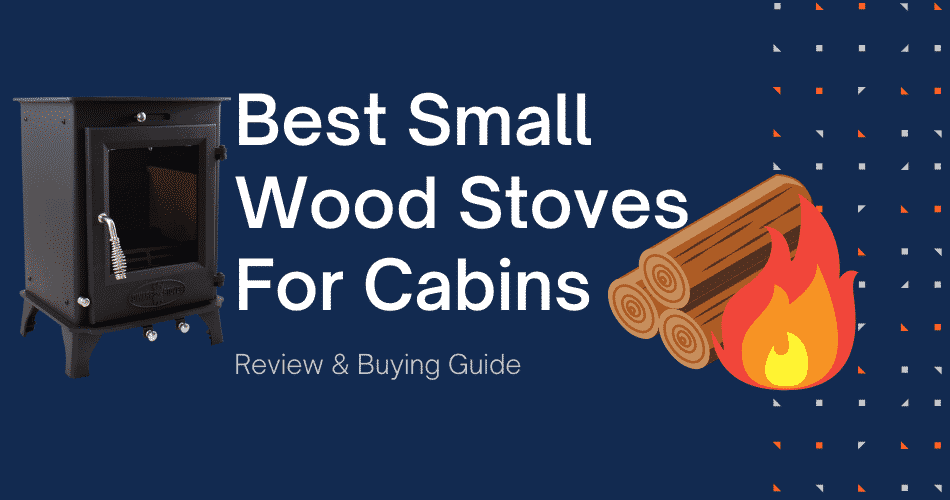Keeping your cabin or other off-grid home warm in winter can be a significant undertaking.
A wood stove is one of the most traditional and effective ways to do it, offering an easy-to-operate solution that often costs next to nothing if you have timber of your own to harvest for fuel.
If you know you need a wood stove but are unsure which one to choose, you came to the right spot.
Unfortunately, to no fault of their own, many people purchase stoves that don’t match their heating needs–and end up way too hot or way too cold–essentially throwing their money down the drain.
I’ve written this article to make sure that doesn’t happen.
I’ve been living off the grid for years and know a thing or two about stoves. Below I’ve broken down exactly how to size a wood stove for your cabin and climate and given some great examples I have experience with to help ensure you pick out the best option for your cabin.
Winters in New York are different than winters in Arizona, and the wood stove you choose should reflect that.
Best Small Wood Stoves For Cabins 2025
For those who want a quick overview, below is our comparison table:
- Our #1 Pick For The Best Cabin Wood Stove: The Dwarf 5kW Wood Stove (Best Small Wood Stove For Cabins Up To 400 Square Feet)
- Our #2 Pick For The Best Cabin Wood Stove: Grizzly Cubic Mini Wood Stove (Runner Up For Best Small Wood Stoves 200-400 Sq. Feet)
- Our #3 Pick For The Best Cabin Wood Stove: Cub Cubic Mini Wood Stove (Best Wood Stove for up to 200 Square Feet)
- Our #4 Pick For The Best Cabin Wood Stove: Timberwolf 2100 Economizer Wood Stove (Best Wood Stove For Cabins Up To 1,500 Square Feet)
- Our #5 Pick For The Best Cabin Wood Stove: Drolet Escape 1800 Wood Stove (Best Wood Stove For Large Cabins 1,500+ Square Feet)

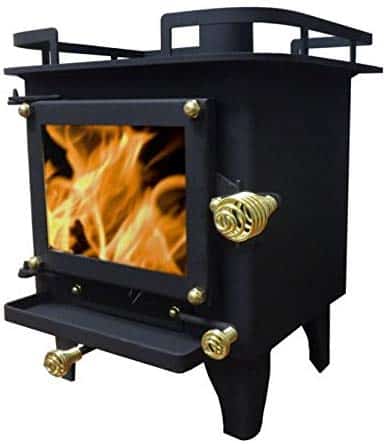




After reading this post, you will learn:
- The most important features to look for in a wood burning stove for your cabin (and how to properly determine how BTUs you need)
- In depth reviews on the best 5 wood stoves
- Three important things to consider when purchasing a wood stove
Our #1 Pick For The Best Cabin Wood Stove: The Dwarf 5kW Wood Stove (Best Small Wood Stove For Cabins Up To 400 Square Feet)

- Design incorporates several control and cleanup features that make it easy to adjust the temperature and clean up after your fire
- Secondary combustion maximizes efficiency to reduce emissions and improve heat output
- Available in 3kW, 4kW, and 5kW versions to let you pick the ideal heat output for cabins under 400 square feet
- Modular design allows you to customize your setup for your needs
- Allows both roof and wall flue exits
- Tertiary air system helps keep glass front clean and soot-free
- Spring handle comes standard, protecting your hands from hot handles
If you have a cabin under 400 square feet, I absolutely love the Dwarf line of wood stoves.
The Dwarf line are modular stoves explicitly designed for tiny homes and other alternative living spaces, and work perfectly for cabins. They come in three sizes, 3kW, 4kW, and 5kW, allowing you to pick the perfect model for your space.
If your home is 200 square feet or less, I recommend the 3kw at 10,200 BTU.
For homes 200-300 square feet, I recommend the 4kw at 13,600 BTU.
And for homes 300-400 square feet, I recommend the 5kw at 17,000 BTU.
Because they’re purpose-built for alternative spaces, you have a lot of flexibility in where and how you install them. They use either a 4″ or 5” flue that can be either roof- or wall-vented and comes designed to allow you to anchor it securely to your floor.
The basic design uses a three-stage combustion system to maximize efficiency and minimize emissions. A secondary combustion airflow valve on the bottom right lets you make adjustments to the temperature and combustion. Simultaneously, a tertiary air valve offers some additional efficiency enhancements and helps keep the stove glass clean and free of soot. It also has a removable ash pan to make cleanup much faster and easier.
What drew me to the Dwarf line was how many great (optional) features you have to choose from. You can go with standard short legs, long legs for less bending, integral wood storage for fewer trips to the woodpile, and even a top-mounted oven for cooking up delicious baked goods on your stove.
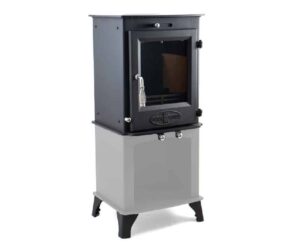
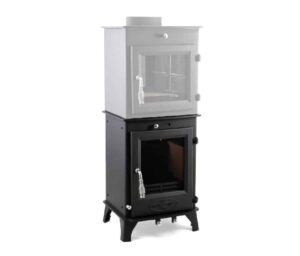
While the stove itself is larger and heavier than some models with comparable performance, I feel the useful accessories and ability to customize it to your space and style make it eminently suitable as a cabin wood stove.
They also have phenomenal reviews (13+ reviews and 4.92 average rating). I found this review by Karen below that shows how great the Dwarf can be for a cabin.
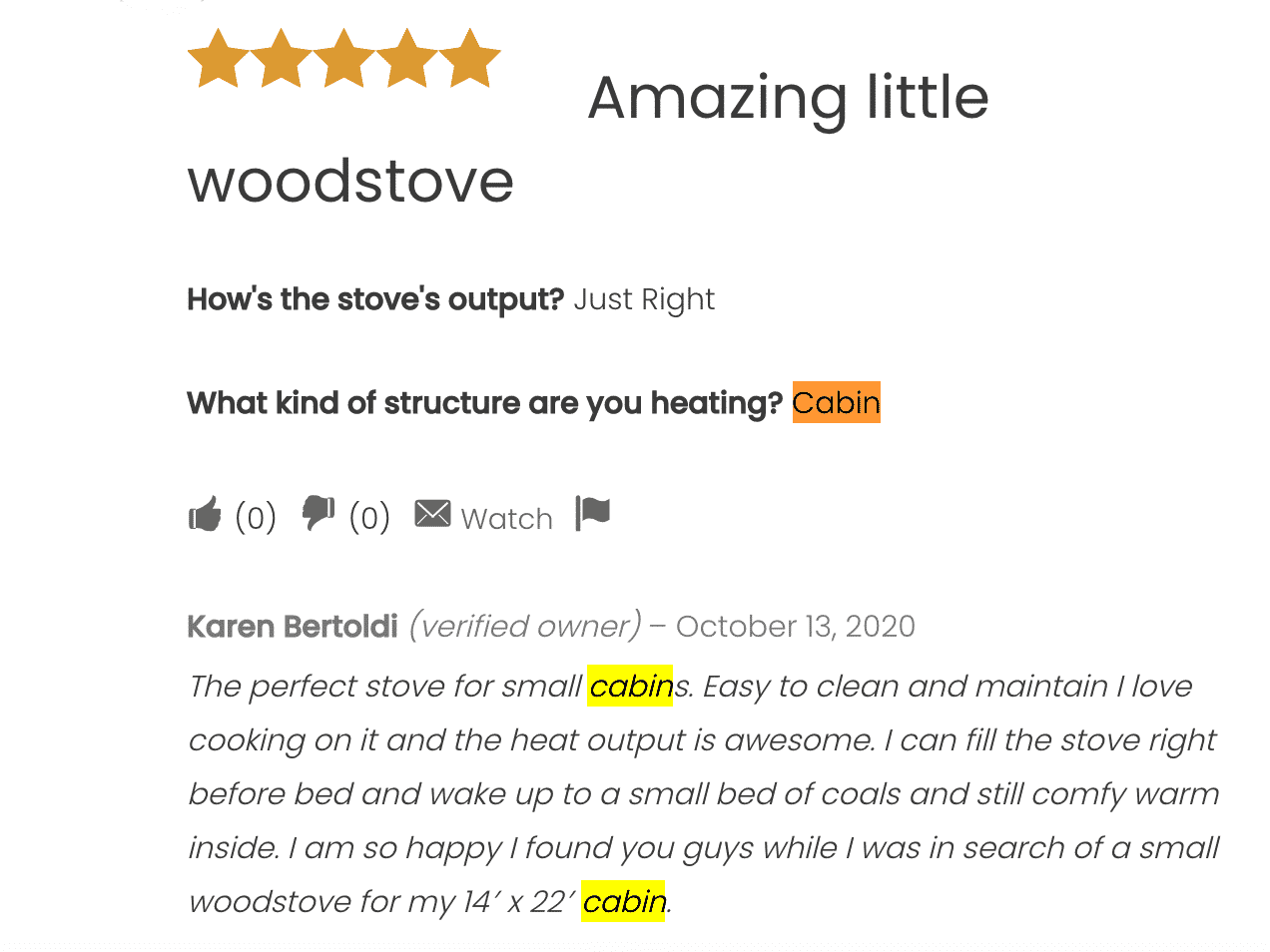
If you’re looking for a great wood stove for your cabin that will keep you warm in the coldest of winters, these are the one you want.
Specifications:
- Size: 22” H x 14” W x 11” D
- Weight: 3kW – 75 lbs, 4kW – 100 lbs, 5kW – 150 lbs
- Flue Diameter: 4″ or 5”
- BTUs: 3kW/10,200 BTU, 4kW/13,600 BTU, 5kW/ 17,000 BTU
- Accepted Wood Size: up to 12”
- Best For: Small to medium cabins or those who want to customize their wood stove
Pros
- Design incorporates several control and cleanup features that make it easy to adjust the temperature and clean up after your fire
- Available in 3kW, 4kW, and 5kW versions to let you pick the ideal heat output for your under 400 square foot cabin
- Modular design allows you to customize your setup for your needs
- Allows both roof and wall flue exit
- Tertiary air system helps keep glass front clean and soot-free
- Spring handle comes standard, protecting your hands from hot handles
Cons
- Large for heat output
- Cast iron construction makes it considerably heavier than some comparable options
Our #2 Pick For The Best Cabin Wood Stove: Grizzly Cubic Mini Wood Stove (Runner Up For Best Small Wood Stoves 200-400 Sq. Feet)
The Grizzly Cubic Mini Wood Stove is a slightly larger and more powerful version of their wildly popular Cub Cubic Mini. It’s about 2” larger in every dimension and produces between 8,000 and 18,000 BTUs.
That’s enough for small cabins up to about 400 square feet or individual rooms of a larger home. It can produce so much heat from such a small footprint through the use of an advanced secondary combustion system.
It’s also what gives it such an extensive range of BTUs produced. A small control lever on the bottom allows you to adjust the amount of oxygen allowed to mix with the heated exhaust, creating more or less heat based on your needs.
I loved how easy it was to install and how tiny the clearances needed were when you take proper precautions. Cubic offers flue kits customized for every climate type plus wall and floor mounting kits to insulate the areas around and beneath your stove. With appropriate insulation, you can install the Grizzly as close as 3” to the walls of your cabin.
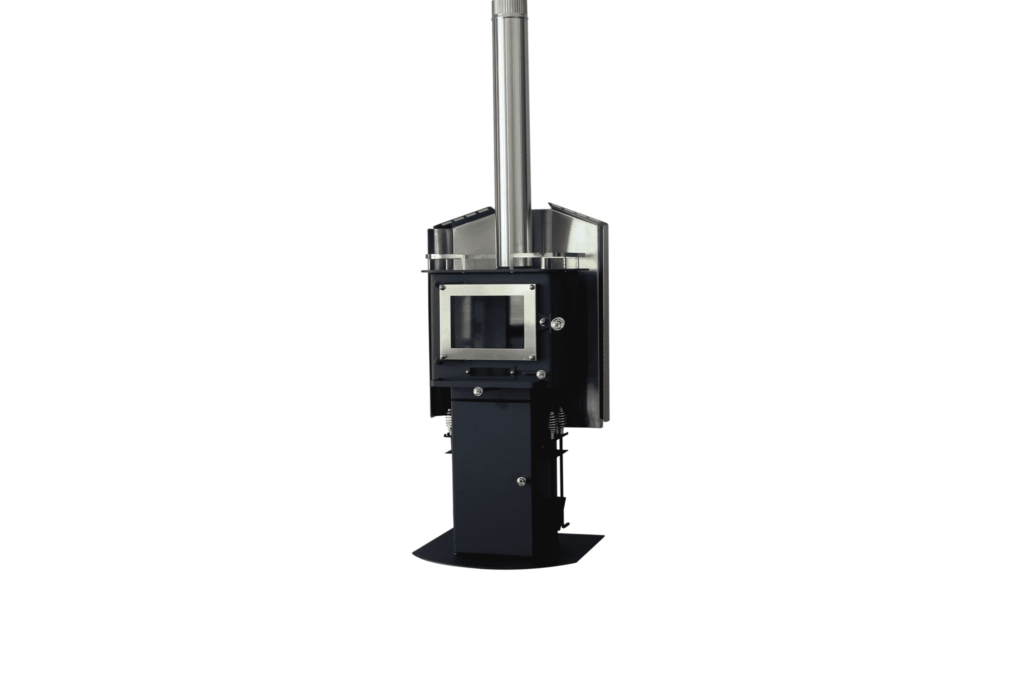
That’s a handy feature if you’re in a very small space.
The Grizzly made my list because of the flexible range of spaces it can effectively heat and its advanced insulation features. You can use it to heat a small single room cabin or easily warm up individual rooms as needed.
Specifications:
- Size: 15” H x 13” W x 12” D
- Weight: 39 lbs
- Flue Diameter: 3” or 5” (When used as part of an insulated exhaust system)
- BTUs: 8,000 – 18,000
- Accepted Wood Size: 6.75” in length
- Best For: Tiny homes, small cabins, off grid retreats, hunting cabins
Pros
- Great choice for wood stoves between 200-500 sq. feet
- More available power than the smaller Cubic Cub Mini
- Secondary combustion system significantly reduces produced smoke and allows you to control the temperature
- Broad BTU range makes it the best option for small to medium spaces
- Accepts wood, charcoal, or pressed logs as fuel
- Freestanding design allows you to place your stove almost anywhere with ceiling access
- The top can be used as a cooktop
Cons
- Small fuel size requires custom cut
Our #3 Pick For The Best Cabin Wood Stove: Cub Cubic Mini Wood Stove (Best Wood Stove for up to 200 Square Feet)

- Extremely lightweight and compact for a wood stove
- Small 3” flue and 3” spacing tolerances, when used with insulated paneling, allow installation in very tight spaces
- The perfect size for heating spaces up to about 200 square feet
- Advanced secondary combustion temperature greatly reduces emissions and allows for a flexible temperature range
- Can run on charcoal, firewood, or pressed logs
The Cub Cubic Mini Wood Stove is one of the smallest yet most potent stoves out there. It measures a positively tiny 12″ H x 11″ W x 10.5″ D yet produces as much as 14,000 BTUs of heat.
Even better, it weighs just 25 lbs when empty and can be floor or wall mounted as needed. That gives you a ton of flexibility in where and how you install your stove and makes it a lot easier to DIY.
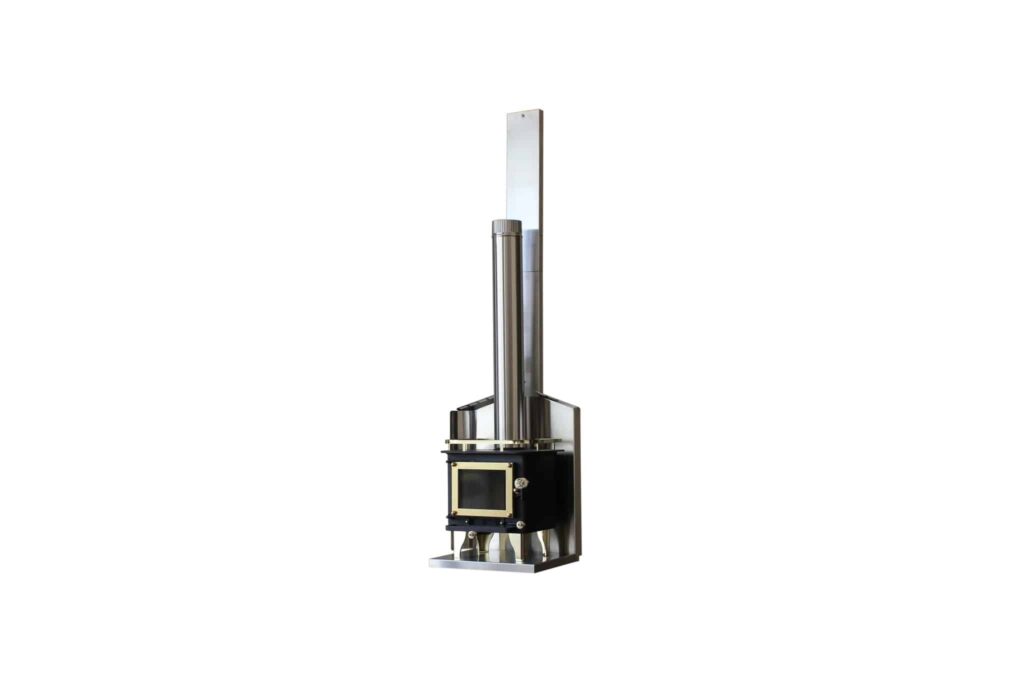
I won’t go too much into the Cub’s performance as it’s identical to the Grizzly, just in a slightly smaller package. It uses the same secondary combustion system and offers the same benefits.
If you like the top-ranked Grizzly Cubic but your cabin is under 200 sq. feet, the Cub Cubic Mini Stove is the one for you.
Specifications:
- Size: 12″ H x 11″ W x 10.5″ D
- Weight: 25 lbs
- Flue Diameter: 3” or 5”
- BTUs: 6,000 to 14,000
- Accepted Wood Size: 5.75” long
- Best For: Very small spaces and individual rooms
Pros
- Extremely lightweight and compact for a wood stove
- Small 3” flue and 3” spacing tolerances, when used with insulated paneling, allow installation in very tight spaces
- The perfect size for heating spaces up to about 200 square feet
- Advanced secondary combustion temperature greatly reduces emissions and allows for a flexible temperature range
Cons
- Small firebox requires use of tiny pieces of firewood
- Only marginally smaller, less powerful, and less expensive than Grizzly Cubic Mini
Our #4 Pick For The Best Cabin Wood Stove: Timberwolf 2100 Economizer Wood Stove (Best Wood Stove For Cabins Up To 1,500 Square Feet)

- Large firebox can accept longer pieces of wood than smaller stoves
- Optional ash pan makes cleanup much faster and easier
- EPA certified to produce just 3.9 grams of emissions per hour
- Firebox burns for a full six hours when filled
- 6” flue is standard for freestanding wood stoves, making it easy to find compatible parts
I know this is a review for small wood stoves, but if you happen to live in a larger cabin, and require some wood stoves with more power, you’ll love the the final 2 stoves on our list.
The Timberwolf 2100 Economizer is a powerful and affordable wood stove great for medium to medium-large off-grid cabins. It produces up to 52,000 BTUs of heat and has a range of optional accessories that make it even more efficient and easy to use–and perfect for cabins up to 1,500 sq. feet.
The Economizer’s design evokes the style of stoves from day’s past yet uses the latest in EPA-certified technology to achieve an 85% efficiency rating. Even better, the larger firebox makes it much easier to get firewood that will fit without cutting your own.
If you choose to purchase the optional ash pan, clean up is much easier than on many other stoves. Instead of having to sweep out the ash from the interior of the stove itself, you can just pull out the ash pan once it has cooled and dump the ashes.
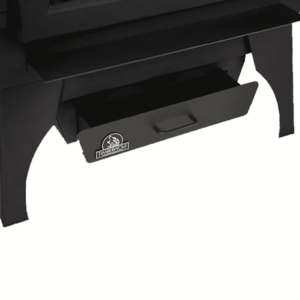
If you have a medium to large cabin that needs heating, you can rely on the Timberwolf 2100 Economizer to do so reliably and for a reasonable price.
Specifications:
- Size: 31 ⅝” H x 26” W x 21 ⅝” D
- Weight: 180 lbs
- Flue Diameter: 6”
- BTUs: up to 52,000
- Accepted Wood Size: up to 18”
- Best For: Larger cabins, large open rooms, Zone 4 and above climates in smaller cabins
Pros
- Top choice for cabins between 1,000-1,500 sq. feet
- Large firebox can accept longer pieces of wood than smaller stoves
- Optional ash pan makes cleanup much faster and easier
- EPA certified to produce just 3.9 grams of emissions per hour
- Firebox burns for a full six hours when filled
- 6” flue is standard for freestanding wood stoves, making it easy to find compatible parts
Cons
- Base unit doesn’t include ash pan, making cleanup more difficult
- Optional accessories individually cost more than some other stoves on my list
- Requires a 19” clearance from the sides and a 17.5” clearance from the rear, taking up a significant amount of space
Our #5 Pick For The Best Cabin Wood Stove: Drolet Escape 1800 Wood Stove (Best Wood Stove For Large Cabins 1,500+ Square Feet)
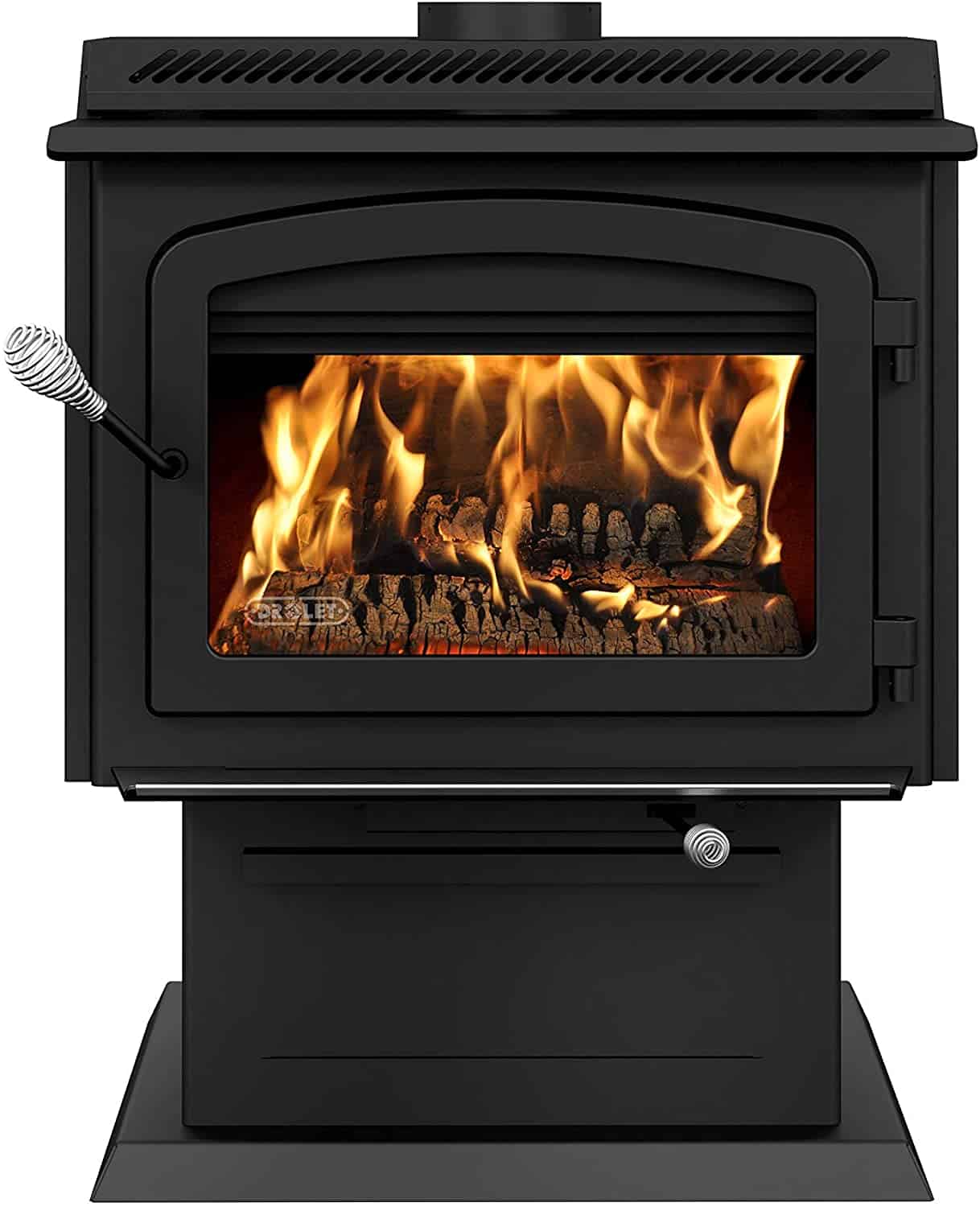
- A large firebox allows you to burn much larger pieces of wood than smaller stoves on my list
- 75,000 BTU heat output ample for larger off-grid cabins or homes in almost any climate zone
- Removable ash drawer makes clean up after each fire much faster and easier
- Burns for up to eight hours on a single load of wood
- A secondary combustion system improves efficiency and reduces emissions to just 1.54g per hour
The Drolet Escape 1800 Wood Stove is a large and powerful pedestal-style wood stove for homes more than 1,500 square feet. It produces up to 75,000 BTUs and can burn for up to eight hours on a single wood load.
Its design is fully EPA certified and incorporates a secondary combustion system to improve efficiency and lower emissions. It has the lowest hourly emissions total of any stove on my list, clocking in at just 1.54g per hour.
Because of its larger size, it can handle significant pieces of firewood as much as 20” long. That makes it a lot easier to purchase firewood if you can’t process your own and reduces the amount of work you have to put in to supply yourself with wood. It also incorporates a removable ash drawer to make clean-up significantly more straightforward.
Unfortunately, the things that make the Drolet great are also downsides when seen from another angle. To start with, it’s large and cumbersome. It’s several times the size of many other stoves on my list and weighs as much as 10-20x as much as some of those.
That makes it a lot more challenging to get into place and properly installed.
Once installed, though, it’s a handsome and powerful wood stove perfect for keeping a larger off-grid cabin nice and toasty.
If your cabin is 1,500 sq. feet, this is the one you want.
Specifications:
- Size: 41” H x 29” W x 28.75” D
- Weight: 367 lbs
- Flue Diameter: 6”
- BTUs: 75,000
- Accepted Wood Size: 20”
- Best For: Large cabins, retreats, lodges, full-size off grid homes, or those living in Zone 5 winter areas
Pros
- Large firebox allows you to burn much larger pieces of wood than smaller stoves on my list
- 75,000 BTU heat output ample for larger off grid cabins or homes in almost any climate zone
- Removable ash drawer makes clean up after each fire much faster and easier
- Burns for up to eight hours on a single load of wood
- Secondary combustion system improves efficiency and reduces emissions to just 1.54g per hour
Cons
- Too large for small cabins
- Very heavy and difficult to move
- 77% efficiency is lower than many other stoves on my list
What I Looked For In A Cabin Wood Burning Stove
When putting this list together, I looked at several key factors that affect how you can use a wood stove. These were heat output, size, cost, and installation difficulty.
The size is directly related to heat output in most cases, with smaller stoves providing less heat using smaller pieces of wood. Likewise, the price increases in proportion to the power and size of a stove.
I focused on each stove’s suitability for heating specific square footage, based on the assumption of a moderately well-insulated cabin or home in a Zone 3 climate. That’s smack dab in the middle of the temperature zones and works perfectly for cabins or other homes in a wide band stretching from Virginia in the East to the borders of Colorado in the West.
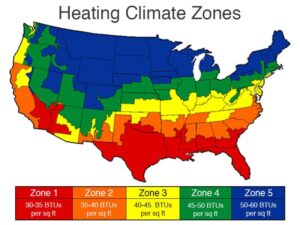
The square footages recommended below are perfect for Zone 3 but still work relatively well in other climates. They’ll be about 20% or so too warm for Zone 1 homes and about 25-30% too cool for Zone 5 homes.
You can find out exactly how many BTUs you need by using this handy calculator.
If you make sure to calculate your correct BTUs for your unique needs by using the calculator above and then choose the stove with the correct BTUs below, I guarantee you will choose the right stove that will keep you warm in the coldest of months.
**Note** As a reminder, the review below is written assuming you live in a Zone 3 climate.
Benefits of a Cabin Wood Stove
Wood stoves have significant benefits over other heating methods, especially when living off the grid. I’ve already covered off grid heating in-depth in its own article, so I’ll briefly touch on the high points here.
Wood stoves are easy to use, simple in their design and installation, and have one of the most widely available and affordable fuel sources out there. If you’re living off grid there’s an excellent chance you can harvest firewood year after year and heat your home at the cost of nothing but a little time.
Even better, firewood is a sustainable fuel. You can grow more in sustainable forestry without depleting some unrenewable stock. With modern wood stoves and their advanced combustion systems, the emissions are also substantially lower than they were in your grandparent’s stove.
There’s also a particular something that comes from a crackling wood fire that I personally feel is irreplaceable. The gentle scent of wood in the air, that wonderful feeling of warmth, and of course the fire itself to gaze into.
All of that adds a little extra something to wood fires that other heating methods just can’t really match.

Small Cabin Wood Stove Buying Guide
Picking out the best wood stove for a cabin comes down to the space you need to heat, your climate conditions, and the installation process. Larger spaces, especially in colder climate zones, require more heat output and
Heat Output and Sizing a Wood Stove for Your Needs
Heat output for wood stoves is measured in British Thermal Units (BTUs). How many BTUs you need will depend on your home’s size and the climate zone you live in. That mainly comes down to elevation and location.
For example, a 500 square foot cabin located in Virginia would need between 20,000 and 22,500 BTUs. That same cabin in the mountains of Colorado would require as much as 30,000 BTUs.
These aren’t exact figures, of course, so you should take into account the level of insulation in your home as well as your personal heat preference.
I prefer a slightly cooler home so I can bundle up with warm blankets but some like it warm.
Cabin Wood Stove Installation and Safety
Stoves range from traditional models that require little more than a heat-resistant spot to sit, and a hole in the roof for a flue up to high-tech catalytic models and wall mounted wood heaters. Ensure you balance the features and performance of a particular stove against the installation’s complexity level.
It’s entirely doable to DIY a wood stove installation if you’re handy, but you should make sure you know what you’re doing. An improperly installed stove without a proper flue can be a severe safety hazard.
here’s a great example of how to install the flue and stove itself from SSLFamilyDad:
Whether you choose to DIY or have your stove professionally installed, make sure you have adequate smoke detectors and especially carbon monoxide sensors in your home.
Cabin Wood Burning Stove Efficiency, Emissions, and EPA Certification
For a long time, wood stoves were just upgraded fireplaces. They allowed you to use the heat from your fire more efficiently and made it easier to cook on, but didn’t significantly alter what happened inside or how much smoke and soot was emitted.
Now though, that couldn’t be further from the truth.
In the U.S., the Environmental Protection Agency (EPA) is the regulatory body for all wood stoves. They maintain strict standards on emissions from wood stoves, including how much soot they can produce.
For consumers, this makes purchasing a quality stove a lot easier. Every residential stove on the market today is required by law to meet EPA standards. That means they’re going to be a lot more efficient, minimum 70% efficient to be precise, and produce more heat for the same amount of fuel while producing fewer emissions.
A few of the stoves above, particularly the very small models, are recreational stoves that aren’t required to meet EPA guidelines. Rest assured, though, that they’re all highly efficient in their size range.
That’s also the reason you won’t find any iconic pot-bellied stoves on my list. Sad to say, those venerable titans of Americana produce too much soot, smoke, and other emissions to meet EPA standards.
Final Thoughts
A wood stove is one of the most affordable and sustainable ways to heat your off grid cabin. They use renewable fuel and produce far lower levels of emissions than in the past.
I’m not going to recommend a ‘best wood stove’ as I usually would because everyone’s needs are different. All of the stoves on this list are excellent products that offer tremendous value and won’t let you down when it counts.
Figure out how many BTUs you need based on your square footage and climate, then find the stove above that matches it.

